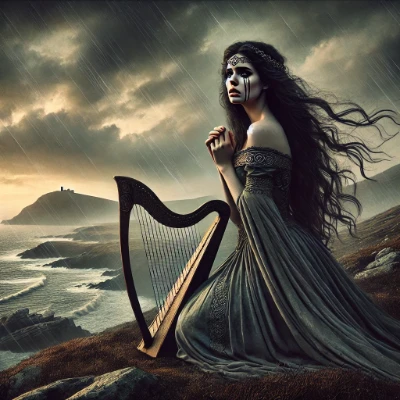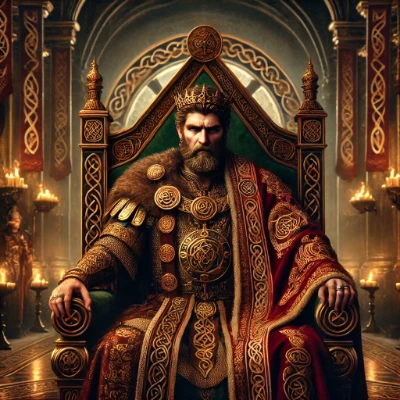Deirdre of the Sorrows: A Look at Love, Loss, and Loyalty
Irish mythology is filled with heroism, romance, and heartache. Still, few tales capture the imagination quite like The Sorrow of Deirdre. Also known by its Irish title Longes mac n-Uislenn or “The Exile of the Sons of Uisliu”, this story comes from the Ulster Cycle, a group of ancient legends centred on the Kingdom of Ulster. Below, we’ll explore its mythological roots, meet its key characters, and see how modern writers have kept this timeless tragedy alive.
Table of Contents
Mythological & Historical Context

Part of the Ulster Cycle
The Ulster Cycle is one of the four major cycles of Irish mythology. It includes tales about legendary warriors like Cú chulainn and kings like Conchobar mac Nessa. The Sorrow of Deirdre stands out for its intense focus on destiny, love, and betrayal. Early forms of the story can be found in medieval Irish manuscripts, ensuring its survival into the modern age.
Cultural Significance
From ancient times, the Irish revered poets and storytellers (the filí) who helped keep such tales alive through oral tradition. As a result, The Sorrow of Deirdre not only survived but also became one of the best-known stories of Irish myth. Its themes—prophecy, love, and loss—remain as captivating now as they did centuries ago.
Key Characters
Deirdre
Deirdre is at the heart of this tragic tale. Foretold to possess a beauty that would bring ruin upon Ulster, she is raised in isolation by King Conchobar to prevent the prophecy from coming true. But fate proves inescapable, and her story unfolds with devastating consequences.
Conchobar mac Nessa
Conchobar is the King of Ulster and an influential figure in the Ulster Cycle. Determined to make Deirdre his wife, he plans meticulously to keep her under his control. His choices set off the tragic events that follow.
Naoise (Son of Uisliu)
Naoise is a brave warrior and strikingly handsome—just as Deirdre envisioned when she first saw a raven on the snow and dreamed of a man with raven-black hair, blood-red cheeks, and skin white as snow. He and Deirdre fall deeply in love, creating a direct conflict with King Conchobar’s plans.
Ainnle and Ardan
Naoise’s loyal brothers share in his fate. They stand by him when he elopes with Deirdre, demonstrating unwavering sibling devotion, even in exile.
Fergus mac Róich
Initially a champion of Conchobar, Fergus is unwittingly drawn into the king’s treachery. When he escorts Deirdre and Naoise back to Ulster on a promise of safety, he has no idea Conchobar intends to betray them.
Plot Overview

Birth & Prophecy
When Deirdre is born, druids predict her beauty will lead to great bloodshed in Ulster. Hoping to avoid this disaster, King Conchobar raises her in secrecy. But as Deirdre grows, her determined spirit sets the stage for tragedy.
Deirdre & Naoise’s Love
One day, Deirdre sees a raven pecking at the blood of a calf against the snow. Fascinated by the contrast of black, red, and white, she declares she will love only a man who bears these colours. Naoise meets that description perfectly. Their love blossoms, defying Conchobar’s intention to marry Deirdre himself.
Elopement & Exile
Fearing the king’s wrath, Deirdre and Naoise flee Ulster, accompanied by Naoise’s brothers. They find refuge, often said to be in Scotland, living peacefully for a time. However, Conchobar concocts a plan, promising them safe passage home. Believing the king’s word, they return, guided by Fergus mac Róich.
Betrayal & Tragedy
Back in Ulster, Conchobar’s treachery is revealed. He kills Naoise and his brothers and forces Deirdre into captivity. Heartbroken, she cannot bear this life of loss and humiliation. In some versions, she leaps from a chariot to her death; in others, she dies of grief. Whichever telling you follow, the outcome remains deeply tragic.
Core Themes
Fate vs. Free Will
Deirdre’s life appears bound by prophecy from the start. Her attempts to escape doom highlight an age-old question: is fate written in stone, or can we change our destiny?
Love & Betrayal
The love between Deirdre and Naoise is pure and unwavering, providing a stark contrast to Conchobar’s manipulative ambition. This clash reveals how easily trust can be betrayed when power is at stake.
Beauty as a Curse
Deirdre’s beauty makes her both desired and feared. The prophecy sets her beauty as a catalyst for destruction, echoing a familiar idea in myths worldwide: that extraordinary gifts often come at a terrible price.
Honour & Loyalty
While Conchobar’s deception spurs tragedy, the loyalty of Naoise’s brothers adds poignancy. Their readiness to follow him into exile underscores the values of kinship and solidarity prevalent in warrior societies.
Modern Writers & Adaptations
W. B. Yeats
Irish myths and folklore profoundly influenced the renowned Irish poet W. B. Yeats. Though he does not have a direct, full-length work exclusively on Deirdre, he often referenced figures from the Ulster Cycle in his poetry and essays, breathing new life into traditional stories.
J. M. Synge
John Millington Synge’s play Deirdre of the Sorrows (completed in 1910) is a significant modern adaptation. Synge focuses on Deirdre’s emotions in her final moments, giving her a strong, tragic voice. His interpretation emphasises her unwavering love for Naoise and her determination to face fate head-on.
Cultural & Literary Impact
Irish Identity
Deirdre’s tragic tale resonates throughout Irish culture. Many see echoes of Ireland’s history of invasion and loss, adding more profound layers of meaning to her story. The sorrow felt in the legend parallels a shared sense of lament and longing in Ireland’s cultural memory.
Global Resonance
Stories of doomed love, relentless fate, and betrayal speak to people worldwide. Much like Greek or Shakespearean tragedies, The Sorrow of Deirdre shows how ambition and power can overshadow beauty and passion.
Conclusion
The Sorrow of Deirdre endures because it deftly weaves timeless human emotions—love, fear, desire, and heartbreak—against a backdrop of warrior culture and looming fate. Even though centuries have passed, readers and audiences still find themselves moved by Deirdre’s struggle against a destiny she never sought and the loyalty and devotion she shows to those she loves. Modern authors, poets, and playwrights continue to draw inspiration from this myth, proving that a great story, once told, will continue to resonate through the ages.
Whether you’re new to Irish mythology or revisiting a familiar favourite, Deirdre’s tragic journey will remind you of the enduring power of storytelling and the unbreakable bond between love and sorrow that echoes across time.
Book Recommendations:
- Gods and Fighting Men by Lady Augusta Gregory (1904)
- Early Irish Myths and Sagas, translated by Jeffery Gantz (Penguin Classics)
- A Dictionary of Celtic Mythology by James MacKillop (Oxford University Press)
